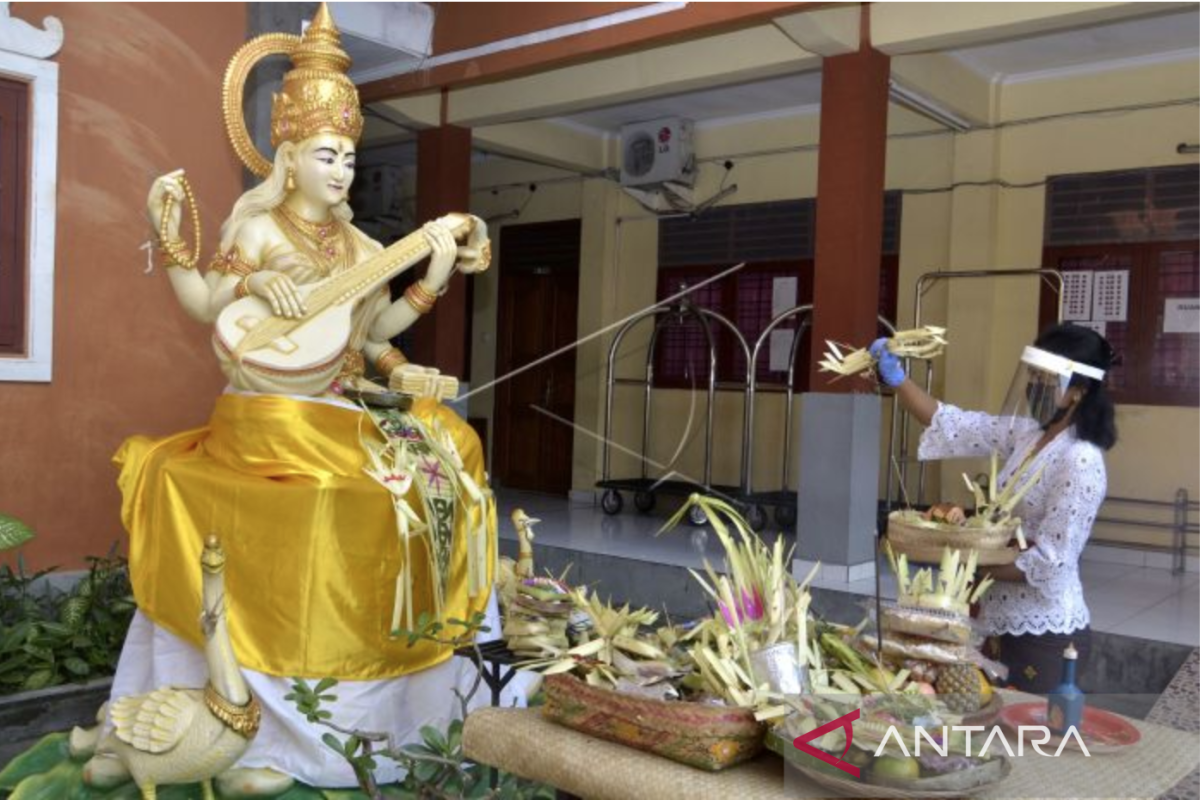Descriptions of the Sarasvati Holy Day can be found in Lontar (script) Suridagama that sheds light on when the holy day is celebrated, which is once every 210 days, specifically on Saniscara Umanis Wuku Watugunung, which is also known as the day when knowledge descends to earth to guide humanity to the rightful path.
In 2023, the Saraswati Holy Day will be celebrated twice—on May 20 and December 16.
In Hinduism, knowledge is associated with Goddess Sarasvati, who is depicted as a beautiful and charming woman.
Chairperson of the Indonesian Hindu Dharma Society (PDHI) of Buleleng, Bali, I Gde Made Metera, said that Goddess Sarasvati is one of the three goddesses of high importance in Hinduism,
In the Vedic scriptures, Goddess Sarasvati, along with Goddess Sri (companion of God Visnu) and Goddess Durga (companion of God Shiva), holds a crucial position in teaching. Sarasvati herself is the companion of God Brahma who represents knowledge.
As the creator of the universe, God Brahma needs Goddess Sarasvati, the Goddess of Knowledge, as pristine knowledge is required in each process of creation.
The meaning of ‘sarasvati’
The word sarasvati is derived from two separate words, namely saras which means “to flow like water” and vati which means “to possess.” Hence, sarasvati represents things that flow in life.
In this context, knowledge always persists in every stage of humans' life, regardless of their age, gender, and any other differences.
I Nyoman Hari Mukti Dananjaya, an academic at Ganesha Education University, said that the occasion of the descent of knowledge to earth is not limited to once every 210 days. Every day, every human being must look for knowledge.
The Sarasvati Holy Day is observed to accord respect to knowledge as a gracious blessing from God.
The celebration of Sarasvati Holy Day serves as a reminder to humans that knowledge is an integral part of life.
With that in mind, one must treat knowledge with high regard as it is required to deal with every worldly matter. That is why humans must appreciate and have a love for knowledge.
Goddess Sarasvati's appearance
Hinduism depicts Goddess Sarasvati as the embodiment of beauty. The goddess is shown as a beautiful woman with four arms, each of them holding different objects with different attributes. Each object has its own meaning, Dananjaya explained.
In one hand she holds a genitri, which symbolizes unlimited and never-ending knowledge, signifying its ever-growing nature.
Additionally, a genitri symbolizes the Hindus' practice of mind control. During meditation, Hindus usually use a genitri as a symbol of their will to placate the ego and control their mind.
In her second arm, Sarasvati holds a keropak or a holy book that symbolizes the importance of scripting and spreading knowledge to the next generations.
In the third arm, she holds a wina that symbolizes the tune of life and serves as a reminder that as creatures gifted with reason and mind, humans must be able to extract knowledge from multiple sources.
Last but not least, in her fourth arm, the goddess holds a lotus flower that symbolizes the sanctity of knowledge. Despite growing in muddy soil, the flower still manages to bloom beautifully. This indicates that knowledge can be used to improve human life.
Apart from her four arms, the goddess exudes charm from her beautiful form that symbolizes knowledge.
In addition to her beauty, Goddess Sarasvati has a swan and a peacock. The former symbolizes the urgency to properly sort knowledge, while the latter symbolizes dignity and elegance.
Myths surrounding the holy day
Besides its meaningful philosophy, the Sarasvati Holy Day is also linked to myths circulated among the Hindu community. One of the myths states that during the holy day, one is forbidden to study or open books.
As per Lontar Sundarigama, studies are forbidden on the holy day as the day must be celebrated through ceremonial rituals to honor the sources of knowledge, such as books or lontars.
Nandajaya confirmed the validity of the written provision. However, he said that the prohibition is limited to half a day's time, given the holy day's celebration only takes place from 6 a.m. to 12 p.m.
"Hence, we are not allowed to study only until 12 p.m. In the evening, we are encouraged to discuss literature with teachers in the hopes of extracting knowledge and minimizing interpretations resulting from self-taught (knowledge),” he added.
Such practices are expected to guide people to always be in a joyous state of mind, perform worship with a sincere and pure heart, and ask for the grace of the Goddess Sarasvati.
Lontar Sundarigama also outlines a list of things that need to be done on Sarasvati Holy Day, including cleaning various knowledge sources, such as books, lontars, writing tools, and so on.
Furthermore, people are also encouraged to neatly arrange knowledge sources and place offerings, such as canang sari or special offerings for the goddess, on top of them.
According to the lontar, offerings such as peras, suci, daksina, penek, ajuman, sesayut Sarasvati, sagara gunung, canang wangi, equipment in yellow and white colors, and duck meat must be made on the holy day.
Other offerings may be added according to one's ability, but the most important thing is the intention and sincerity of the believers.
Once all the offerings are gathered, people proceed with a prayer ritual that involves chanting Sarasvati's special mantra. One day after the holy day, Hindus perform the Banyupinaruh tradition by visiting nearby water sources, such as beaches, rivers, and other sources, in the morning before sunrise for the purpose of self-purification.
The Sarasvati Holy Day is celebrated not only by students, but also by people from all levels of Hindu society. This inclusiveness symbolizes the obligation for humans, as living beings born with higher intelligence than others, to constantly hone their knowledge.
The holy day should not only be celebrated once in half a year because human beings must be able to realize themselves on the holy day by seriously implementing knowledge.
In fact, the holy day is not only celebrated by Hindus in Indonesia. Hindus in several other countries, including Japan, Germany, Belgium, the Netherlands, India, and the US also celebrate this holy day with their own respective local customs.
Related news: Bali: Hindus hold Tawur Agung Kesanga ceremony
Related news: Hindus sanctify Prambanan Temple after 1,163 years
Translator: Putu Shinta. Widodo S, Tegar Nurfitra
Editor: Azis Kurmala
Copyright © ANTARA 2023












